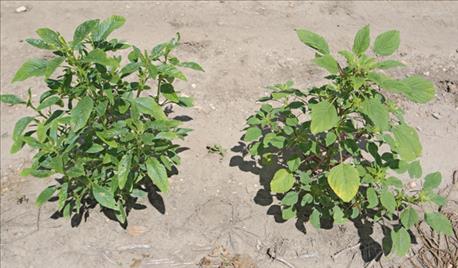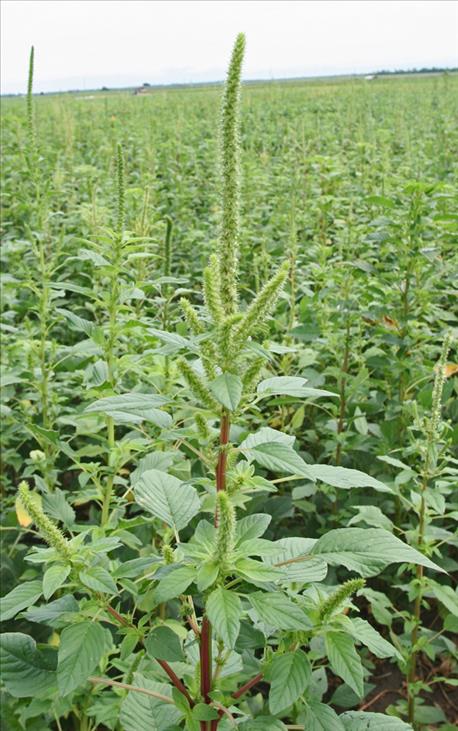
It has been seen in other states. It has been rumored to be in our own. But a field in St. Charles County this year confirmed that multi-herbicide-resistant Palmer amaranth is in Missouri.
In the Mississippi River bottoms just north of St. Louis, Palmer amaranth plants were growing in fields. Samples and further testing by Southern Illinois University researchers Karla Gage and Ronald Krausz confirmed that the Palmer amaranth population found was resistant to glyphosate and group 14 PPO inhibitors.

NEW RESISTANCE: Southern Illinois University researchers confirmed that Palmer amaranth growing in a field north of St. Louis is multi-herbicide-resistant. (Photo courtesy University of Missouri)
According to Mandy Bish, University of Missouri Division of Plant Sciences research specialist, this is the first known case of Palmer amaranth population in Missouri with resistance to postemergence application of group 14 herbicides like the fomesafen found in products like Flexstar and Marvel, lactofen found in Cobra, or aciflurofen in Ultra Blazer. She says Missouri does have Palmer that is resistant to one mode of action, just not multiple modes.
Tennessee was the first state to discover PPO resistance in Palmer amaranth just last year. There are also populations in southern Illinois. "Palmer amaranth is native to the Southwest region of the United States," Bish explains. "But it has spread to the Southeast, and now is migrating up to the Midwest. Most of the Palmer amaranth coming into Missouri, we are assuming, has some resistance. Farmers need to treat it that way."

LOOK ALIKE? For many farmers it is hard to distinguish between waterhemp (left) and Palmer amaranth (right). Long petioles on the Palmer amaranth, along with broader leaves that look more like those of a poinsettia, distinguish it from the waterhemp.
Worse than waterhemp
Missouri has been home to herbicide-resistant weeds like waterhemp for a few years. Both waterhemp and Palmer amaranth are members of the pigweed family. "But Palmer is the dominant cousin of waterhemp," Bish says. "It is more difficult to control, because it produces more rapidly and grows larger in the field."
Waterhemp grows 1 to 1¼ inches per day. Palmer amaranth grows 2 to 2½ inches per day. "If you don't see Palmer or miss it in a field, then return four to five days later — at its growth rate, it is too tall to treat."
Palmer amaranth is prolific. One plant can produce 500,000 seeds. Bish says research in Arkansas shows that when seed is introduced to a field from a resistant plant, it only takes three years for the field to be completely covered with that resistance. "We are trying to get producers to understand how important it is that we do not let Palmer amaranth set seed in the field," she adds.
Aggressive treatment
Research shows that Palmer amaranth is much more competitive with soybeans than waterhemp. According to Bish, research shows that when there are as few as five Palmer plants per 2-foot soybean row, yields reduce by as much as 79%.

SEED-SETTER: The Palmer plant seed head can reach more than 1.5 feet tall. According to University of Missouri researchers, there is no other pigweed seed head that long. It is capable of producing 500,000 seeds per plant.
Faced with harvest losses, perhaps it is time farmers take an old-school approach to weed control and incorporate non-chemical options. "We need to consider tillage," she says. "We want to prevent as many pigweeds as possible from emerging."
Results from an MU-led research collaboration shows that deep tillage in combination with residual, preemergent herbicide can reduce the number of pigweeds that emerge by 97%, when compared to minimum tillage with no preemergent herbicide.
While Palmer amaranth can produce high volumes of seed, that seed does not have a long life. The seed is only viable for up to five years in the soil, but more importantly, Bish says, is needs sunlight to germinate. One pass of deep tillage can bury the seed at least 2 inches and help reduce the spread. If farmers have seen Palmer amaranth or waterhemp in a field this year, they will want to put down a preemergent herbicide in the spring.
Farmers must remain vigilant when scouting for Palmer amaranth next year. For those weed escapes during the season, it is important to gain control with chemicals before the plant reaches 4 inches in height.
Spreading problems
Stopping the spread of Palmer amaranth is complicated, given that there are many ways the weed can be transported into the state — or even from field to field.
Farmers should be careful when it comes to pollinator or Conservation Reserve Program mixes. "Many of these are not completely clean," Bish says.
Equipment can also be a source for spreading resistant weeds between fields.
However, there is one transport method farmers cannot control — wildlife. Bish says MU research shows that ducks and geese can move herbicide-resistant weed seed from one field to another.
Bish encourages farmers to let her department know when herbicide-resistant weeds pop up in a field. "We want to keep track of what we have in the state, and where it is located."
About the Author(s)
You May Also Like






